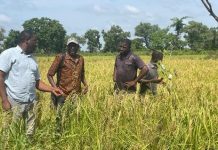By Nelson Manneh
In the heart of Bafuloto, located within the Kombo North District of The Gambia’s West Coast Region, a stark labor reality unfolds. Women and men are seen tirelessly breaking stones while balancing the weight of their children on their backs. This scene highlights the urgent challenge facing quarry workers: the high risk of musculoskeletal disorders (MSDs), particularly affecting the lower back.
The physically taxing nature of quarry work exposes these laborers to severe health risks. Activities such as lifting heavy loads, performing repetitive tasks, and contorting their bodies into awkward positions are commonplace—elements that contribute significantly to the prevalence of MSDs. These disorders encompass a multitude of conditions that impact muscles, tendons, ligaments, nerves, and blood vessels, manifesting as back pain, neck pain, and other joint issues.
A recent study focusing on this vulnerable workforce in The Gambia found a staggering 93% of quarry workers reported experiencing MSDs. The most affected areas included the lower back (90.3%), shoulders (68.1%), and upper back (61.3%). Alarmingly, the study also identified a lack of awareness and formal reporting concerning MSDs and potential hazards among these workers.
“Quarrying used to be a trade for strong men, but now both men and women are engaged in this grueling work. Unfortunately, we lack the necessary equipment to perform our tasks effectively,” lamented Maimuna Camara, a laborer at the Bafuloto quarry. She emphasized the physical toll the job takes, which is exacerbated by inadequate ergonomic training and unsafe working conditions.
Veteran worker Lamin Fadera, who has dedicated over two decades to quarrying, echoed this sentiment. “It’s a heavy job, but it pays well,” he stated, noting the pressing need for better tools rather than relying solely on physical power. Workers like Fadera traverse from one site to another, grappling with the limitations imposed by outdated equipment.
The economic necessity of quarrying comes at a stark price. Arafang Colley, another worker interviewed on-site, highlighted the challenges posed by heavy machinery utilized by construction companies. As they extract stones with their escalators, quarry workers find it increasingly difficult to access quality materials, forcing them to expend even more physical effort digging through harder ground.
The implications of MSDs are profound. These injuries range from minor strains to chronic conditions such as arthritis, significantly impairing work productivity and the quality of life. Health expert Malang Dampha remarked on the specific impact of quarry work on the lower back, attributing it to repetitive lifting and awkward postures endemic to the job.
In addition to musculoskeletal concerns, quarrying generates considerable dust, introducing respiratory risks as well. Dampha noted, “Quarrying releases large amounts of dust, including particulate matter (PM10), which can lead to serious health issues like asthma and silicosis.”
To address the urgent plight of quarry workers, experts are calling for comprehensive interventions. Recommendations include updating existing labor laws and occupational health and safety standards, which currently do not adequately protect these laborers. Furthermore, implementing ergonomic training, providing modern equipment, and scheduling routine health checks could drastically improve the working conditions for this critical workforce.
As the community seeks solutions to these pressing health concerns, the voices of quarry workers continue to resonate, pleading for guidance and support that can lead to safer and healthier work environments.


















